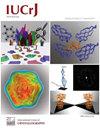High-resolution synchrotron X-ray study of icosahedrite, an icosahedral AlCuFe quasicrystal from the Khatyrka meteorite
IF 3.6
2区 材料科学
Q2 CHEMISTRY, MULTIDISCIPLINARY
引用次数: 0
Abstract
A single grain of the icosahedral AlCuFe quasicrystal extracted from the Khatyrka meteorite has been studied by means of high-resolution synchrotron X-ray diffraction at the ESRF. We found that the mineral is a phason-wave modulated icosahedral quasicrystal, a feature already observed for synthetic quasicrystals. This result might be used as a tracer to shed light on the thermal history of the meteorite.
Icosahedrite, natural icosahedral Al63Cu24Fe13, was discovered in a meteorite about 15 years ago. We have carried out a high-resolution X-ray diffraction study on a sample of this meteoritic mineral at the ESRF. The diffraction pattern turned out to be identical to an intermediate phase observed in synthetic i-AlCuFe during the transformation from the quasicrystalline state to a periodic rhombohedral phase. This particular natural Al63Cu24Fe13 grain is an icosahedral quasicrystal on which a modulation by six cosine waves propagating along the fivefold axes is superimposed, with a wavelength of about 20 nm and a polarization in the phason/perpendicular space. By examining the thermodynamic conditions for producing this modulated icosahedral phase at high pressure in the laboratory, we may gain insights into the formation process of the Khatyrka meteorite.
Khatyrka陨石中二十面体AlCuFe准晶体的高分辨率同步x射线研究。
二十面体陨石,天然二十面体Al63Cu24Fe13,是大约15年前在一块陨石中发现的。我们在ESRF对这种陨石矿物的样本进行了高分辨率x射线衍射研究。该衍射图与合成i-AlCuFe准晶向周期菱形相转变过程中观察到的中间相一致。这种特殊的天然Al63Cu24Fe13晶粒是一种二十面体准晶体,其上叠加了沿五重轴传播的六个余弦波调制,波长约为20 nm,在相位/垂直空间中具有偏振。通过在实验室中研究高压下产生这种调制二十面体相的热力学条件,我们可以深入了解卡提尔卡陨石的形成过程。
本文章由计算机程序翻译,如有差异,请以英文原文为准。
求助全文
约1分钟内获得全文
求助全文
来源期刊

IUCrJ
CHEMISTRY, MULTIDISCIPLINARYCRYSTALLOGRAPH-CRYSTALLOGRAPHY
CiteScore
7.50
自引率
5.10%
发文量
95
审稿时长
10 weeks
期刊介绍:
IUCrJ is a new fully open-access peer-reviewed journal from the International Union of Crystallography (IUCr).
The journal will publish high-profile articles on all aspects of the sciences and technologies supported by the IUCr via its commissions, including emerging fields where structural results underpin the science reported in the article. Our aim is to make IUCrJ the natural home for high-quality structural science results. Chemists, biologists, physicists and material scientists will be actively encouraged to report their structural studies in IUCrJ.
 求助内容:
求助内容: 应助结果提醒方式:
应助结果提醒方式:


